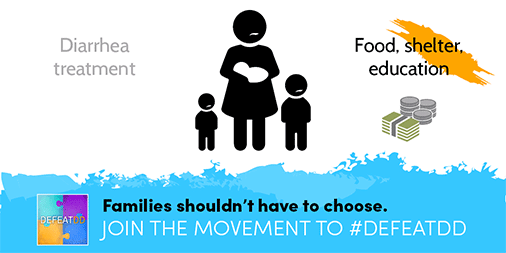
An impossible choice: The dangerous disruption of diarrhea treatment costs

Many families are forced to make the impossible choice between treatment and family finances when their children fall ill with diarrheal disease.
Diarrheal disease isn’t just a medical problem—it’s an economic one, too. We’ve heard from families around the world how the costs of diarrhea treatment can significantly interrupt parents’ livelihoods as well as education, food, and shelter for the rest of the family. A study published in the British Medical Journal provides powerful evidence and deeper insights into the economics of diarrheal disease for families in Malawi. To help break it down, we’re sharing a few of the study’s most important findings.
Finding 1: The cost of diarrhea treatment can push families into poverty—at all income levels.
This study, as with many others, found a significant financial burden from childhood diarrheal disease to both the healthcare system and to households. Strikingly, the costs of seeking treatment for severe diarrhea bring the income of the majority of families surveyed in all income groups below the national poverty line in the month of illness. For the lowest income group surveyed, the costs of treating one episode of diarrhea were more than the family’s entire monthly income in more than a quarter of households. Even among the highest income group, nearly 20 percent of households were brought temporarily below the poverty line by the costs of treating diarrhea.
While the lowest-income settings in Malawi are at highest risk of impoverishment—often due to having little or no savings on hand to cover medical costs—diarrhea imposes a serious economic threat to families of all income levels in Malawi.
Finding 2: Lost income and transportation costs account for half of total household costs.
Of the average total household expenditures for one case of diarrhea, half of the costs were a combination of lost income, transportation to and from the hospital, and meals and lodging at the hospital. Such indirect, non-medical expenses are easy to overlook when evaluating the cost of care, but they can add up to have a significant impact on families.
Finding 3: Urban and rural experiences with diarrhea treatment differ.
When costs were compared between the urban and rural settings, the study found that overall household costs were higher for the urban setting. One reason for this may be that, compared to the rural hospital, more patients at the urban hospital had been seen at other healthcare facilities (e.g., a local clinic) first. Families who were at their second facility had spent twice as much, largely because of the transportation required to get to the urban hospital.
This suggests that many families may be unable to find adequate care at their local clinics and need to drive great distances to the urban hospital to get needed treatment. Improving availability of first-line diarrhea treatments such as ORS and zinc could help prevent the need for families to travel far distances to reach urgent care.
Read the full study and find more interesting tidbits here. Treating a child’s diarrhea episode should not push families into poverty, but unfortunately, it does far too often. However, in places where access to healthcare is challenging, the emergence of vaccines and other preventive measures—better access to water and sanitation, proper handwashing, and good nutrition—keeps more and more families physically and financially safe from disaster. Through an integrated prevention and treatment approach, we can defeat diarrhea before it depletes what little hard-earned savings a family may have and pushes them into a cycle of poverty and illness.
You can help raise awareness of the problem. Share our gif with your networks and let us know why you think families shouldn’t have to choose to between treatment for their children and basic necessities.


